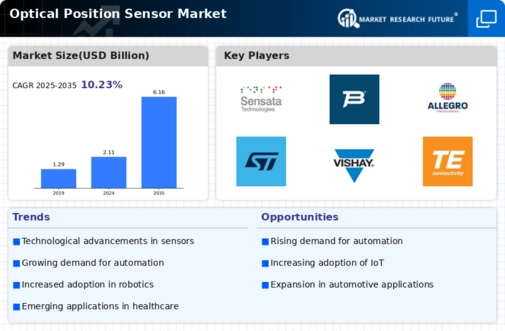Market Trends
Key Emerging Trends in the Optical position sensor Market
The Optical Position Sensor Market is experiencing notable trends that shape its trajectory and drive innovation in the sensor technology landscape. One prominent trend is the increasing demand for miniaturization. With the development of electronic products that are smaller and more compact, there is a demand for optical position sensors with small dimensions yet efficient in terms on space. This trend is increasingly prevalent in the consumer electronics industry, with a focus on embedding advanced sensing into products without losing their overall size and build quality. Therefore, the pressure to produce miniaturized optical position sensors that meet up with modern day requirements for compact and stylish electronic devices continues.
A second notable trend is the advent of Industry 4.0 and the Industrial Internet of Things (IIoT). The fact that industries have adopted smart manufacturing and automation makes the optical position sensors very important in giving precise information for industrial processes. These sensors are integral parts of smart factories, which make it possible to control and monitor machinery or equipment with high accuracy. The use of optical position sensors alongside IIoT platforms elevates connectivity and data-driven decisions, advancing industrial operations efficiency and productivity.
The market is also experiencing increased adoption of non-contact sensing technologies. Optical position sensors have the following advantages due to their non-contact measurement mechanisms: minimal wear and tear, higher reliability, accuracy in measurements than contact mechanism based sensor. This trend is particularly applicable in industries such as automotive, aerospace and medical devices that need reliability and maintenance free operation. The increased use of non-contact sensing reflects a wider trend within the industry and it aims at technologies that reduce mechanical stresses improving the system lifetime.
Additionally, more attention is paid to creating sensors that have improved weather resistance. The design of optical position sensors is geared toward withstanding extreme temperatures, humidity and contaminants. This trend is characterized by the many uses of optical position sensors in applications such as for automotive and aviation fields where sensors are prone to hostile environmental conditions. Their capability to operate consistently under harsh conditions improves these sensors in terms of long-term stability and adaptability.
Being one of the emerging trends in the Optical Position Sensor market, sustainability plays an important role. As the themes of green become more prevalent, manufacturers are implementing eco-friendly practices in sensor manufacture. These include the use of environmentally friendly materials, energy-efficient manufacturing process and recyclability. Sensors with smaller per capita footprints fulfill the industry trend towards environmentally friendly and socially responsible manufacturing.
Finally, customization and variability become must-have trends in the optical position sensor market. Manufacturers are concentrating on sensors that can be customized to satisfy particular needs of the clients and usage requirements. Customization may involve adapting sensor specifications, interfaces, or form factors to suit diverse industries and applications. This trend caters to the increasing demand for versatile solutions that can address the unique challenges of various sectors.











Leave a Comment